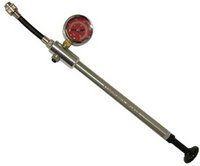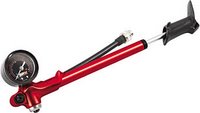Shock Pumps
 Around three years ago, the choice of shock pumps was quite limited and this Brand-X unit was pretty much all that was available. However, it has a clear and accurate gauge up to a thumping 300psi, a blow off valve enabling you to accurately set the psi and a flexible hose (albeit short) that helps when fitting and pumping. All it's needed throughout it's life is an occassional regrease of the internal o-ring.
Around three years ago, the choice of shock pumps was quite limited and this Brand-X unit was pretty much all that was available. However, it has a clear and accurate gauge up to a thumping 300psi, a blow off valve enabling you to accurately set the psi and a flexible hose (albeit short) that helps when fitting and pumping. All it's needed throughout it's life is an occassional regrease of the internal o-ring. However, with the recent domination of air can's lots more shock pump desgins are now available. They're typically smaller, lighter and have a folding flexible hose that makes fitting and storage even easier. The one shown here is a Marzocchi copy and look remarkably similar to those supplied with Rockshox and Manitou equipment. The gauge and blow off valve still remain so the earlier units got something right.
However, with the recent domination of air can's lots more shock pump desgins are now available. They're typically smaller, lighter and have a folding flexible hose that makes fitting and storage even easier. The one shown here is a Marzocchi copy and look remarkably similar to those supplied with Rockshox and Manitou equipment. The gauge and blow off valve still remain so the earlier units got something right.When acquiring a pump you need to be certain whether your shock is a high (up to 300psi) or low (up to 175psi) unit to acquire the correct pump. You'll typically find that Fox bouncers are high pressure whereas any 5th Element, Rockshox, Manitou's SPV and Marzocchi shocks are typically (tho not exclusively) low pressure. Using a high pressure pump on a low pressure shock is viable but they're not accurate enough to accommodate the smaller range of adjustment. The fact that shocks can be used on forks and shox's can make for an interesting set of pumps in the toolbox but most bikes now tend to use either high or low pressure and not a combination - although it's not unheard of.
The valve outer (thread) can often cause a few headaches as we've found that the 5th Element and Cannondale valves are slightly smaller than say a Fox.


0 Comments:
Post a Comment